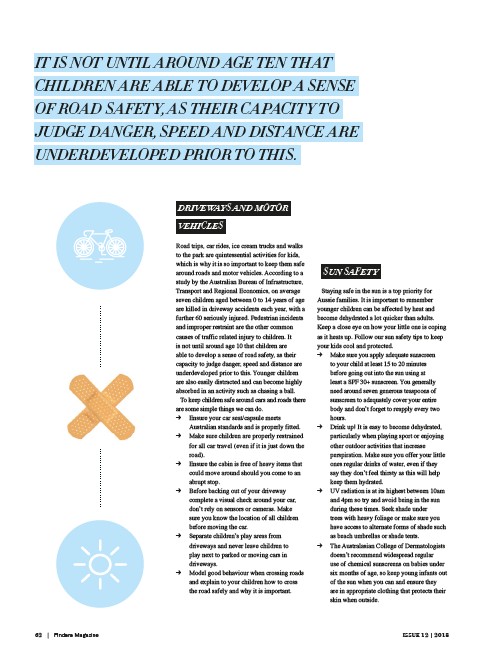
IT IS NOT UNTIL AROUND AGE TEN THAT
CHILDREN ARE ABLE TO DEVELOP A SENSE
OF ROAD SAFETY, AS THEIR CAPACITY TO
JUDGE DANGER, SPEED AND DISTANCE ARE
UNDERDEVELOPED PRIOR TO THIS.
DRIVEWAYS AND MOTOR
VEHICLES
Road trips, car rides, ice cream trucks and walks
to the park are quintessential activities for kids,
which is why it is so important to keep them safe
around roads and motor vehicles. According to a
study by the Australian Bureau of Infrastructure,
Transport and Regional Economics, on average
seven children aged between 0 to 14 years of age
are killed in driveway accidents each year, with a
further 60 seriously injured. Pedestrian incidents
and improper restraint are the other common
causes of traffic related injury to children. It
is not until around age 10 that children are
able to develop a sense of road safety, as their
capacity to judge danger, speed and distance are
underdeveloped prior to this. Younger children
are also easily distracted and can become highly
absorbed in an activity such as chasing a ball.
To keep children safe around cars and roads there
are some simple things we can do.
Ensure your car seat/capsule meets
Australian standards and is properly fitted.
Make sure children are properly restrained
for all car travel (even if it is just down the
road).
Ensure the cabin is free of heavy items that
could move around should you come to an
abrupt stop.
Before backing out of your driveway
complete a visual check around your car,
don’t rely on sensors or cameras. Make
sure you know the location of all children
before moving the car.
Separate children’s play areas from
driveways and never leave children to
play next to parked or moving cars in
driveways.
Model good behaviour when crossing roads
and explain to your children how to cross
the road safely and why it is important.
SUN SAFETY
Staying safe in the sun is a top priority for
Aussie families. It is important to remember
younger children can be affected by heat and
become dehydrated a lot quicker than adults.
Keep a close eye on how your little one is coping
as it heats up. Follow our sun safety tips to keep
your kids cool and protected.
Make sure you apply adequate sunscreen
to your child at least 15 to 20 minutes
before going out into the sun using at
least a SPF 30+ sunscreen. You generally
need around seven generous teaspoons of
sunscreen to adequately cover your entire
body and don’t forget to reapply every two
hours.
Drink up! It is easy to become dehydrated,
particularly when playing sport or enjoying
other outdoor activities that increase
perspiration. Make sure you offer your little
ones regular drinks of water, even if they
say they don’t feel thirsty as this will help
keep them hydrated.
UV radiation is at its highest between 10am
and 4pm so try and avoid being in the sun
during these times. Seek shade under
trees with heavy foliage or make sure you
have access to alternate forms of shade such
as beach umbrellas or shade tents.
The Australasian College of Dermatologists
doesn’t recommend widespread regular
use of chemical sunscreens on babies under
six months of age, so keep young infants out
of the sun when you can and ensure they
are in appropriate clothing that protects their
skin when outside.
62 | Pindara Magazine ISSUE 12 | 2018